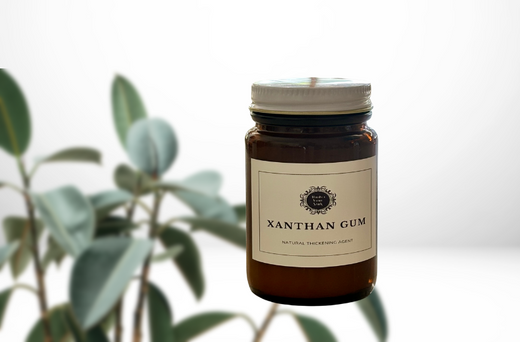
Xanthan Gum to thicken your water based products
Analisa Malone
When it comes to DIY beauty and cleaning products, Xanthan Gum is your go-to for thickening water-based products, turning them into smooth gels.
- Perfect for making dish liquid, hand wash, and other DIY cleaners more consistent and easier to use!
- Works as an emulsifier and stabiliser, keeping oil and water-based ingredients from separating. Magic!
- Great for DIY beauty products too! It helps create smooth, easy-to-apply face masks, thickens lotions and creams without any harsh chemicals.
- It’s also used in cooking as a thickener for sauces, soups, and gravies without adding extra calories.
How do you use it? (read this its important)
Similar to when you are thickening a soup with corn flour, if you put the corn flour directly in, chances are you will get clumps and need to thoroughly mix it.
Same with Xanthan Gum, when you add it directly to water-based solutions it will form clumps – so you need to use a blender or whisk until its all blended through.
The amount of Xanthan Gum needed will vary depending on the desired consistency. Generally, a ratio of 0.1% to 0.3% works best but seriously that is some math, so here is my tip of the day!!
I usually add ½ a teaspoon of Xanthan Gum to 1 tablespoon of Glycerine. This forms a beautiful gel that you can then mix – clump free - into your solution. This usually up to 1 litre of solution. Start of small, you can always add more and if you overdo it, simply dilute it down.
Now, for those of you who like to deep dive into ingredients like me.. keep reading
What exactly is Xanthan Gum and where does it come from?
It is a fine ground powder with a similar feel to corn flour, made through a natural fermentation process using a bacterium found in cabbage known as Xanthomonas campestris.
First, bacteria are fed a sugar solution, like corn syrup. As they consume the sugars, they produce xanthan gum as a gel-like substance.
The mixture is then dried and ground into a fine powder, which becomes the Xanthan gum we use.
What makes it eco-friendly
It's created through natural fermentation using bacteria and simple sugars. This process avoids the need for extensive chemical treatments and is resource efficient. Additionally, Xanthan gum is biodegradable, breaking down harmlessly in the environment. Tick!
Beyond DIY Cleaners
Here’s a list of other uses for Xanthan Gum beyond DIY products:
-
Thickening Sauces & Soups: Adds texture and consistency without extra calories.
-
Gluten-Free Baking: Mimics gluten's structure to improve the texture and rise of gluten-free breads, cakes, and cookies.
-
Emulsifier in Salad Dressings: Keeps oil and vinegar mixed together in dressings.
-
Smoothies & Ice Cream: Adds thickness and creaminess
-
Cosmetics & Skincare: Used to thicken lotions, creams, and serums, providing a smooth, luxurious texture.
-
Pharmaceuticals: Used to suspend liquids and help with controlled-release medications.
-
Personal Care Products: Used in hair gels, deodorants, and facial masks to achieve smooth consistency and texture.
-
Pet Food & Supplements: Used in some pet food products to improve texture and consistency.
- Industrial & Household Products: Used as a stabiliser and thickener in paints, coatings, and household cleaning products.
You can grab Xanthan Gum and Glycerine here in our DIY ingredients collection - in keeping with our full green approach they come in plastic free packaging.
Just a quick note: While our Xanthan Gum is food-grade quality, Under Your Sink isn’t a food supplier. For safety reasons, we recommend using it exclusively in your DIY beauty and cleaning products.
